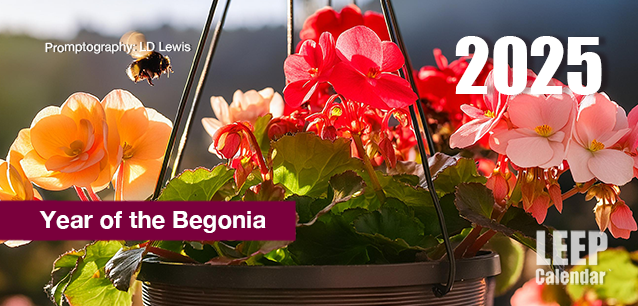 AD
AD
Today is: May 09
Scroll to explore events active on this date.
LEEP INK FEATURES

Events in April 2025
Spring has sprung in the north, and the first hints of Autumn are on the horizon in the south. April is the month spring (or fall) gets underway, and it is filled with religious celebrations, including the Mu...

Metamorphic March: Trends and events in March 2025
Welcome to Spring or Autumn. This is a transitional month with something for everyone. Internationally, it is Women's History Month, focusing on the achievements, needs, and challenges that women ...

February Favorites
The world steps into the second month of 2025 with hope and trepidation. The United States has a new administration. Canada is finding its way to a new administration. Germany and several other European nations...
About 2025, the International Year of the Begonia
Ends: Dec 31, 2025
DESCRIPTION:
2025 IS THE YEAR OF BEGONIA
The Fleuroselect Home Garden Association has declared 2025 as the Year of the Begonia, a celebration that shines a spotlight on the enchanting beauty and versatile charm of this beloved flower. This initiative is designed to inspire and intrigue, raising awareness about the diverse types of begonias, their origins, and their widespread uses in gardens and homes worldwide.TYPES OF BEGONIAS
Begonias come in diverse species and varieties, each offering unique beauty and appeal. The most common types include:
Tuberous Begonias (Begonia tuberhybrida)—These begonias are popular in hanging baskets and container gardens because they are known for their large, colorful blooms and ability to thrive in shady areas.
Fibrous Begonias (Begonia semperflorens)— or wax begonias, are characterized by their small, waxy leaves and continuous blooming throughout the growing season. They are often used as bedding plants.
Rhizomatous Begonias (Begonia rex-cultorum)—Valued for their striking foliage, multicolored or patterned, these begonias are commonly grown as houseplants.
Cane Begonias (Begonia coccinea)—Recognized by their tall, bamboo-like stems and clusters of flowers, cane begonias are often grown indoors and can reach impressive heights.ORIGIN AND HISTORICAL SIGNIFICANCE
Begonias, with their roots in tropical and subtropical regions, have a rich history. Most species originated from South America, Central America, Africa, and Asia. The genus Begonia was first described by the French botanist Charles Plumier in the 17th century, and it is named in honor of Michel Bégon, a French patron of botany. This historical connection adds a layer of depth and interest to the world of begonias.POPULAR USES OF BEGONIAS
Begonias remain prized for their versatility and aesthetic appeal. The most popular ways people use begonias include:
Ornamental Gardening—Begonias are a favorite for adding vibrant color and texture to gardens, particularly in shaded areas where other flowers might struggle in flower beds, borders, and ground cover.
Container Gardening—Ideal for patios, balconies, and indoor spaces, begonias thrive in pots and hanging baskets. Their diverse forms and colors make them a popular choice for container gardening.
Houseplants—Many begonias, especially those with ornamental foliage like rex begonias, are grown indoors. They add a touch of greenery and color to interior spaces, brightening rooms and improving air quality.
Fleuroselect Home Garden Association's Year of the Begonia will feature various events and initiatives aimed at promoting the cultivation and appreciation of begonias. Activities will include gardening workshops, floral exhibitions, and educational campaigns highlighting the care and propagation of begonias.
VIDEOS
SUPPORTING DOCUMENTS
Currently, this event does not have supporting documents.
ADDITIONAL IMAGES
Currently, this event does not have supporting images.
Where would you like to go now?
 AD
AD


/footer-logo.svg)
